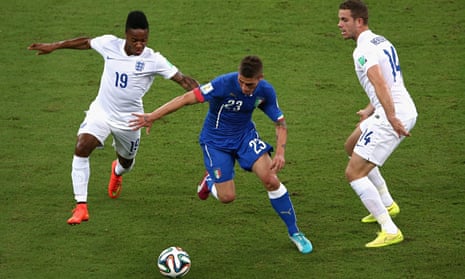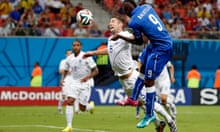Clash of styles
These two countries favour completely different styles of football – England are about speed and energy, Italy about possession and patience. In an evenly matched contest like this there is always a danger the managers will compromise their regular game plan by attempting to negate the other side’s strength. Instead the coaches concentrated on maximising their side’s own strengths, which was obvious from their selection decisions. Roy Hodgson did not deploy an extra central midfielder to compete in the centre of midfield – he picked Raheem Sterling, another speedster. Cesare Prandelli did not opt to bring more pace into his side – he selected the young deep-lying playmaker Marco Verratti to ensure Italy’s dominance. Such variety in style is what the World Cup is all about, and the different approaches created an intriguing tactical battle.
Italy dominate on the right
The key feature of the first half was Italy’s dominance down their right side, where England had two problems. The first issue was the intelligent movement of Antonio Candreva, who floated between a right-wing position and a No10 role, showing the spatial awareness that Prandelli believes compensates for Candreva’s relative lack of technical quality. Candreva’s movement on that flank narrowed England, with Leighton Baines dragged inside, and opened up space for Matteo Darmian on the overlap. The right-back needed no invitation to scamper down the touchline to receive diagonal balls from Italy’s creative, inventive midfielders. Wayne Rooney, presumably not played in his favoured No10 position because of questions over his defensive responsibility against Andrea Pirlo, was found lacking in a defensive sense and Italy made inroads in this position shortly before their opening goal. Hodgson immediately switched Rooney and the more disciplined Danny Welbeck after the break, but it was futile: Darmian and Candreva again combined to cross for Mario Balotelli’s header.
Rooney’s assist
However, England’s equaliser had arrived precisely because Rooney was not tracking Darmian. Shortly after Claudio Marchisio opened the scoring, Darmian went on another scamper forward on the counter-attack, briefly becoming Mario Balotelli’s closest support. However, as Italy failed to locate Darmian, and Candreva’s forward pass went astray, Rooney now found himself in a position to break into the space Darmian had left behind. He charged forward, was found by Sterling’s measured through-ball and provided an excellent left-footed cross, inviting Daniel Sturridge to half-volley into the net. Hodgson clearly wasn’t happy with Rooney’s defensive efforts, but there are positives to leaving a dangerous attacker free of defensive responsibilities.
Sterling looked lively in the centre
A clear bright spot was Sterling, whom Hodgson entrusted with the crucial No10 role. Although Sterling expected to be facing Pirlo, instead he was up against the more combative Daniele De Rossi but the Liverpool youngster was fearless, happy to shut him down and dribble past into attack. The central attacking midfielder in this 4-2-3-1 system is responsible for so much – connecting the midfield and attack, drifting laterally to support the wide players and setting the tone for his side’s creative play. Hodgson’s approach is all about attacking quickly and directly rather than dominating possession, and Sterling’s ability to quicken the tempo with a sudden burst of speed is absolutely perfect.
Although a winger by trade, Sterling thrived at the head of Liverpool’s diamond last season, and on this showing, there’s no reason he can’t continue in this central role.
Balotelli's dangerous runs
Balotelli remains one of the most unpredictable players in world football. When in the mood he is a brilliantly ruthless central striker capable of converting half-chances into goals but, if uninterested, he drifts around on the periphery of matches. The quality of Balotelli’s runs is the major thing that changes. As Italy threatened down the right throughout the first period, Balotelli’s movement was lazy – as the only crossing target, he frequently positioned himself between Gary Cahill and Phil Jagielka, making it easy for the England centre-backs. After the break, however, Balotelli varied his movement. He held back towards the far post to convert Candreva’s cross and put Italy ahead, then a few minutes later darted towards the near post for yet another Candreva ball, where he was inches away from scoring Italy’s third. When he varies his movement, Balotelli is the complete striker.











Comments (…)
Sign in or create your Guardian account to join the discussion